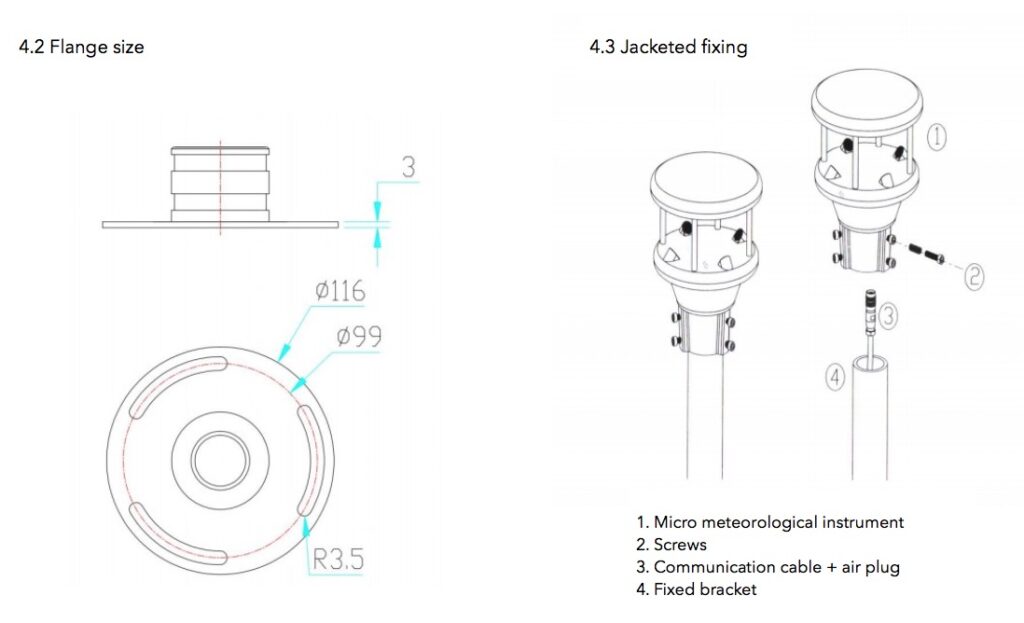In train meteorological services, wind speed and wind direction are indispensable meteorological elements during train operation. The accuracy of wind speed and wind direction data will directly affect the safety of train operation. Therefore, in order to ensure the safe operation of trains, strong wind monitoring systems have been established in railway stations and railways in various regions to monitor and warn in real time and direct the trains. The ultrasonic wind speed and direction sensor is one of the main sensors of the gale monitoring system, and its output accuracy has an important guiding role for the train.
Why choose ultrasonic wind speed and direction sensor?
Ultrasonic wind speed and direction sensor can provide accurate and reliable wind speed and wind direction data, which is one of the key elements to ensure the safety of railway transportation in windy areas. The wind area railway has the characteristics of large wind speed change range and fast wind direction change. The dynamic response characteristics of the ultrasonic wind speed and wind direction sensor can just meet the requirements of railway safety.
The working principle of ultrasonic wind speed and direction sensor
The working principle of the ultrasonic wind speed and direction sensor is the ultrasonic time difference method, because the propagation speed of sound in the air will be superimposed with the airflow speed in the wind direction. If the propagation direction of the ultrasonic wave is in the same direction as the wind, its speed will increase; on the contrary, if the propagation direction of the ultrasonic wave is opposite to the wind direction, its speed will be slowed down. Therefore, under fixed detection conditions, the speed of ultrasonic propagation in the air can correspond to the wind speed function. The wind speed and direction can be obtained by calculation.

Features of ultrasonic wind speed and direction sensor
1. The SenTec ultrasonic wind speed and direction sensor adopts an upside-down design, which can avoid rain and snow interference and no fear of wind and sand blockage. Compared with products without an upside-down design on the market, the measurement is more accurate and the service life is longer. This technology has been patented.
2. The SenTec ultrasonic wind speed and direction sensor has built-in electronic compass selection equipment, and there is no azimuth requirement during installation, just ensure that it is installed horizontally. There is also no need to ensure that the N on the housing must point to the north during installation.
3. The ultrasonic wind speed and direction sensor has no starting wind speed limit, zero wind speed operation, no angle limit, 360° all-round measurement, breaking through the angle problem, and can obtain wind speed and wind direction data at the same time.
4. The ultrasonic wind speed and direction sensor adopts random error identification technology, which can ensure low discrete error of measurement and stable output data even under strong wind.
5. The shell of the ultrasonic wind speed and direction sensor is made of ABS material, which is light in weight, easy to carry and easy to disassemble.
6. The ultrasonic wind speed and direction sensor adopts an integrated design, high IP66 protection level, no moving parts, small wear, and longer service life. It can easily cope with various harsh environments and ensure stable and accurate data output.


Installation method of ultrasonic wind speed and direction sensor
The installation method of ultrasonic wind speed and direction transmitter is relatively simple. First put the device on the pole. It should be noted that there is a protruding N word on the device without the optional electronic compass, so that the N word is facing the north to avoid measurement errors. Then use a wrench to tighten the screw against the pole and you can use it. When installing the equipment, the wiring sequence must not be wrong.
Application scenarios of ultrasonic wind speed and direction sensor
The ultrasonic wind speed and direction sensor is a wind speed and direction measuring instrument developed based on the ultrasonic principle. It uses the transmitted sound wave pulse to measure the time difference of the receiving end to calculate the wind speed and wind direction. Compared with other types of wind speed and direction sensors, the ultrasonic wind speed and direction sensor has anti-interference. With the characteristics of strong ability and high measurement accuracy, it is widely used in railway stations, airports, ports, laboratories and other environments.




